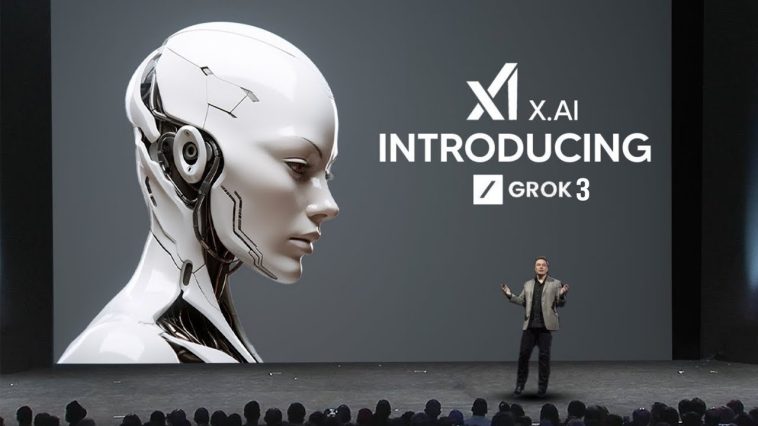Last month, Elon Musk’s artificial intelligence venture xAI introduced their latest contribution to the advanced AI realm – Grok 3. This move signifies the company’s bold entry into a territory largely controlled by major names like Google, OpenAI, and China’s DeepSeek. During a live broadcast, Musk unveiled Grok 3 to be a ‘high-fidelity truth-seeking AI’ that thrives on precision, even when it risks confronting popular sentiments. He professed it to be a significant step forward in terms of reasoning and computational efficiency.
Musk confidently asserts that Grok 3 surpasses other leading AI models such as GPT-4o, Gemini 2 Pro, and DeepSeek-V3 in terms of performance. His claim is substantiated by Grok 3’s impressive internal evaluation scores and an over 1,400 score in LMArena’s Chatbot Arena. For those unfamiliar, LMArena’s Chatbot Arena is an open-source AI benchmarking leaderboard curated by UC Berkeley’s SkyLab.
In addition to its superior performance, Grok 3 brings forth some innovative features. The ‘Think Mode’ is designed to handle real-time problem-solving tasks and the ‘Big Brain Mode’ is intended for processing more intensive computational work. In the current AI landscape, these unique features set Grok 3 apart from its counterparts.
DeepSearch is another distinctive attribute of Grok 3, designed to parallel the efficiency of Google Search and other AI-focused search alternatives such as OpenAI’s Deep Research, DeepSeek’s Search Mode and Perplexity AI’s Pro Search. Thanks to Grok 3’s remarkable capabilities, Musk’s venture could disrupt the established order in the AI space.
xAI’s incredible AI model, Grok 3, is the result of meticulous endeavors by their elite team comprising of ex-Big Tech researchers and engineers. But what makes Grok 3 so efficient and forward-thinking? According to information retrieved from xAI’s blog, the punch behind Grok 3’s capabilities is a feature called ‘Test-Time Compute at Scale’ or TTCS. This particular test-time scaling implementation empowers Grok 3’s reasoning abilities.
TTCS in Grok 3 adjusts computational resources dynamically to deliver increased accuracy for intricate inquiries while preserving quick response times for simpler tasks. This strategic application of machine learning in Grok 3 could open the doors to groundbreaking innovations, including potentially discovering a cure for lung cancer if the model is combined with dedicated compute clusters for extended reasoning periods.
The unprecedented implementation of Test-Time Compute Clusters in conjunction with an advanced reasoning model that can consume and process real-time data is a game-changing approach in today’s AI development scene. This strategy was first publicly shared by xAI at the Grok 3 launch event.
The development of Grok 3 also entailed the usage of Colossus, the prodigious supercomputer cluster that was constructed by xAI. Loaded with a whopping 200,000 Nvidia H100 GPU accelerators, this massive infrastructure played a pivotal role in building the powerful AI model – Grok 3.
Out of the numerous Nvidia H100 GPUs housed in Colossus, xAI used 100,000 to design Grok 3. By committing 200 million GPU hours, xAI managed to deliver ten times the GPU hours used during Grok 2’s training setup. Musk announced, promising that the subsequent generation of the Colossus training cluster is slated to enhance its power fivefold, thereby raising anticipations.
Despite Musk’s optimism and assurances, the feasibility of xAI’s rapid growth, the lofty claims around Grok 3’s capabilities, and its competitive might vis-a-vis AI-search rivals like OpenAI’s Deep Research attracts significant skepticism. Critics argue that escalating computational power inadvertently balloons costs and turns model deployment prohibitively expensive, indicating a potentially unsustainable business model.
Critics also raise concerns over biases inherent in AI models, owing to the nature of the data they are trained on. The notion that AI can be unerringly neutral is largely disagreed upon. Proponents, however, believe that Grok 3 has the potential to vie with Google Search on general topics, provided xAI continues to reinforce training.
There are speculations that specialized topics might be a domain where Google Search would not hold any significant advantage over AIs like Grok that have been trained on highly specialized data. Grok 3’s DeepSearch function exhibited striking competence during initial tests, outshining Google’s Gemini models. However, the function has shown intermittent issues with spontaneous generation of cites and URLs.
The reviews for DeepSearch have been mixed so far, with assessments placing it around the functionality of Perplexity’s DeepResearch, though not quite on par with OpenAI’s most recent ‘Deep Research’ yet. Despite being remarkably proficient, DeepSearch is viewed as needing more refinement to be deemed as thorough and reliable as its competitors.
Musk’s claims regarding Grok 3 have undoubtedly set a high benchmark for the AI industry. Only time will tell if Grok 3 is able to live up to these lofty expectations, change the paradigm of the AI world, and successfully navigate the issues that come with increased growth and computational power.


